|
 |
 |
|
| 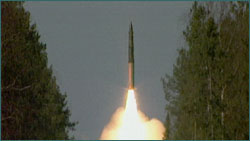 In the past quarter century, Russia and the United
States each have come close twice to launching nuclear missiles to counter a
perceived attack. Above, Russia's premier ICBM, the TOPOL M, in a test
firing.
In the past quarter century, Russia and the United
States each have come close twice to launching nuclear missiles to counter a
perceived attack. Above, Russia's premier ICBM, the TOPOL M, in a test
firing.
|
False Alarms on the Nuclear Front
by Geoffrey Forden
The Cuban missile crisis is the best-known example of narrowly avoiding nuclear
war. However, there are at least four other less well-known incidents in which
the superpowers geared up for nuclear annihilation. Those incidents differed
from the Cuban missile crisis in a significant way: They occurred when either
the U.S. or Soviet or Russian leaders had to respond to false alarms from
nuclear warning systems that malfunctioned or misinterpreted benign events.
All four incidents were very brief, probably lasting less than 10 minutes each.
Professional military officers managed most of them. Those officers had to
decide whether or not to recommend launching a "retaliatory" strike before
possibly losing their own nuclear first strikes. In three of the four
incidents, the decision not to respond to the alarm was made when space-based
early-warning sensors failed to show signs of massive nuclear attacks. The
fourth incident was caused by an inadequate early-warning satellite system that
was fooled into thinking that reflected sunlight was the flames from a handful
of ICBMs.
As the following brief history of those four incidents makes clear, space-based
early-warning systems played a major role in avoiding nuclear war. During the
1980s, a few specialized articles in the media hinted at the presence of those
systems. However, it was only during the Gulf War that the American public
truly became aware of U.S. capability to detect missile launches using
space-based assets. During that crisis, U.S. Defense Support Program (DSP)
satellites, first orbited in 1970, detected the launch of every Iraqi Scud
missile. The satellites made the detections from their orbits by "seeing" the
infrared light that the missiles' motors gave off during powered flight. The
warning of launches was transmitted to Patriot air defense missile batteries in
Israel and Saudi Arabia to support attempts to shoot down the incoming
warheads.
The association with the fighting of conventional war has obscured
the more important strategic role those systems have played: reassuring leaders
of the United States and Russia that they were not under nuclear attack. A
review of the four nuclear crises will better highlight that role.
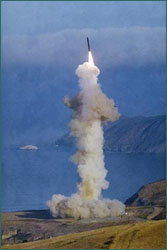 Early on the morning of November 9, 1979, control centers for
American Minuteman missiles, such as the one above, went on high alert for a
harrowing several minutes.
Early on the morning of November 9, 1979, control centers for
American Minuteman missiles, such as the one above, went on high alert for a
harrowing several minutes.
|
|
The training tape incident
Shortly before 9 a.m. on November 9, 1979, the computers at North American Aerospace
Defense Command's Cheyenne Mountain site, the Pentagon's National Military
Command Center, and the Alternate National Military Command Center in Fort
Ritchie, Maryland, all showed what the United States feared most—a massive
Soviet nuclear strike aimed at destroying the U.S. command system and nuclear
forces. A threat assessment conference, involving senior officers at all three
command posts, was convened immediately. Launch control centers for Minuteman
missiles, buried deep below the prairie grass in the American West, received
preliminary warning that the United States was under a massive nuclear attack.
The alert did not stop with the U.S. ICBM force. The entire continental air
defense interceptor force was put on alert, and at least 10 fighters took off.
Furthermore, the National Emergency Airborne Command Post, the president's
"doomsday plane," was also launched, but without the president on board. It was
later determined that a realistic training tape had been inadvertently inserted
into the computer running the nation's early-warning programs.
|
 In the "training tape" incident, Defense Support Program early-warning
satellites saved the day. Above, a $256 million DSP satellite goes aloft in
August 2001.
In the "training tape" incident, Defense Support Program early-warning
satellites saved the day. Above, a $256 million DSP satellite goes aloft in
August 2001.
|
However, within minutes of the original alert, the officers had reviewed the
raw data from the DSP satellites and checked with the early-warning radars
ringing the country. The radars were capable of spotting missiles launched from
submarines close to the U.S. shores and ICBM warheads that had traveled far
enough along their trajectories to rise above the curvature of the Earth. The
DSP satellites were capable of detecting the launches of Soviet missiles almost
anywhere on the Earth's surface. Neither system showed any signs that the
country was under attack, so the alert was canceled.
The computer chip incident
On June 3, 1980, less than a year after the incident involving the training tape,
U.S. command posts received another warning that the Soviet Union had launched
a nuclear strike. As in the earlier episode, launch crews for Minuteman
missiles were given preliminary launch warnings, and bomber crews manned their
aircraft. This time, however, the displays did not present a recognizable or
even a consistent attack pattern as they had during the training tape episode.
Instead, the displays showed a seemingly random number of attacking missiles.
The displays would show that two missiles had been launched, then zero
missiles, and then 200 missiles. Furthermore, the numbers of attacking missiles
displayed in the different command posts did not always agree.
Although many officers did not take this event as seriously as the incident of
the previous November, the threat assessment conference still convened to
evaluate the possibility that the attack was real. Again the committee reviewed
the raw data from the early-warning systems and found that no missiles had been
launched. Later investigations showed that a single computer chip failure had
caused random numbers of attacking missiles to be displayed.
The autumn equinox incident
On September 26, 1983, the newly inaugurated Soviet early-warning satellite system
caused a nuclear false alarm. Like the United States, the Soviet Union realized
the importance of monitoring the actual launch of ICBMs. However, the Soviets
chose a different method of spotting missile launches. Instead of looking down
on the entire Earth's surface the way U.S. DSP satellites do, Soviet satellites
looked at the edge of the Earth—thus reducing the chance that naturally
occurring phenomena would look like missile launches. Missiles, when they had
risen five or ten miles, would appear silhouetted against the black background
of space. Furthermore, when the edge of the Earth is viewed, light reflected
from clouds or snow banks has to pass through a considerable amount of the
atmosphere. That view reduces the chances that clouds and snow may cause false
alarms.
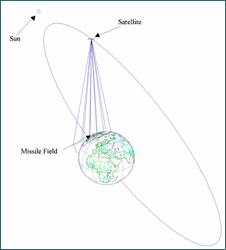 A Russian Oko early-warning satellite's hypothesized view of
U.S. missile fields at the time of the so-called "autumn equinox" incident.
A Russian Oko early-warning satellite's hypothesized view of
U.S. missile fields at the time of the so-called "autumn equinox" incident.
|
|
A satellite has to be in a unique position to view a recently launched missile
silhouetted against the black of space. To get that view, the Soviet Union
picked a special type of orbit that it had used for its communications
satellites. Those orbits, known as Molnyia orbits, come very close to the Earth
in the Southern Hemisphere but extend nearly a tenth of the distance to the
moon as the satellite passes over the Northern Hemisphere. From that position
high above northern Europe, the Soviet Union's Oko ("Eye") early-warning
satellites spend a large fraction of their time viewing the continental U.S.
missile fields at just the right glancing angle. However, shortly after
midnight Moscow time on September 26, 1983, the sun, the satellite, and U.S.
missile fields all lined up in such a way as to maximize the sunlight reflected
from high-altitude clouds.
Whether that effect was a totally unexpected phenomenon is hard to know. That
may have been the first time this rare alignment had occurred since the system
became operational the previous year. Press interviews with Lt. Col. Stanislav
Petrov, the officer in charge of Serpukhov-15, the secret bunker from which the
Soviet Union monitored its early-warning satellites, indicated that the new
system reported the launch of several missiles from the U.S. continental
missile fields. Petrov had been told repeatedly that the United States would
launch a massive nuclear strike designed to overwhelm Soviet forces in a single
strike.
Why did that false alarm fail to trigger a nuclear war? Perhaps the Russian
command did not want to start a war on the basis of data from a new and unique
system. On the other hand, if the sun glint had caused the system to report
hundreds of missile launches, then the Soviet Union might have mistakenly
launched its missiles. Petrov said that he refused to pass the alert to his
superiors because "when people start a war, they don't start it with only five
missiles. You can do little damage with just five missiles."
The Norwegian rocket incident
Early on the morning of January 25, 1995, Norwegian scientists and their American
colleagues launched the largest sounding rocket ever from Andoya Island off the
coast of Norway. [Sounding rockets collect data on atmospheric conditions from
various altitudes.] Designed to study the northern lights, the rocket followed
a trajectory to nearly 930 miles altitude but away from the Russian Federation.
To Russian radar technicians, the flight appeared similar to one that a U.S.
Trident missile would take to blind Russian radars by detonating a nuclear
warhead high in the atmosphere.
| 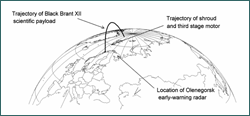 The trajectory of the Black Brant XII sounding rocket, which
triggered the "Norwegian rocket" incident.
The trajectory of the Black Brant XII sounding rocket, which
triggered the "Norwegian rocket" incident.
|
That scientific rocket caused a dangerous moment in the nuclear age. Russia was
poised, for a few moments at least, to launch a full-scale nuclear attack on
the United States. In fact, President Boris Yeltsin stated the next day that he
had activated his "nuclear football"—a device that allows the Russian
president to communicate with his top military advisers and review the
situation online—for the first time.
However, we can be fairly confident that Yeltsin's football showed that Russia
was not under attack and that the Russian early-warning system was functioning
perfectly. In addition to the string of radars surrounding the border of the
former Soviet Union, Russia had inherited a complete fleet of early-warning
satellites that, even by 1995, still maintained continuous 24-hour coverage of
the U.S. continental missile fields. In the early 1990s Russia had still
managed to launch replacement satellites for its early-warning system as the
previous ones died out—thereby retaining continuous coverage. Because of
those satellites, Yeltsin's display must have shown that no massive attack was
lurking just below the horizon.
Towards reliable early warning
The danger posed by those incidents was not the unauthorized or accidental
launch of a handful of nuclear-tipped missiles but the possibility that either
country might misinterpret a benign event—a computer training tape
mistakenly inserted into an operational computer or sunlight glinting off
clouds during a rare lineup of the sun, Earth, and satellite—and decide to
launch a full-scale nuclear attack.
Each incident caused officials to take steps to solve a specific problem. After
the training tape incident, the U.S. Department of Defense constructed a
separate facility to train operators so that a training tape could not again be
inserted into the computer running the nation's early-warning system.
Apparently, the Soviet Union launched a new fleet of early-warning satellites
into geostationary orbit simply to provide a second angle from which to view U.S.
missile fields. That expensive and redundant system ensured that at least one
satellite could search for missile launches free from sun glint.
After three of the four incidents, the U.S. government maintained that steps
were taken that would prevent any future false alarms. However, it had to wait
only seven months after the first incident (the computer tape incident) to see
that complex organizations, relying on even more complex machinery, can find
new and unexpected ways to fail. In fact, a comprehensive study of nuclear
accidents has shown convincing historical evidence that, despite measures taken
to prevent them, such accidents are inevitable.
| 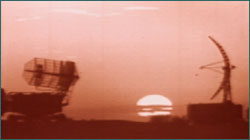 Despite
careful measures to insure nuclear accidents never happen, history reveals that
such mishaps are inevitable. Are we prepared for the next one?
Despite
careful measures to insure nuclear accidents never happen, history reveals that
such mishaps are inevitable. Are we prepared for the next one?
|
The most recent example of solving the "last problem" was the Clinton
administration's initiative to share early-warning data with Russia. The
jointly manned center has been presented by the American side as a solution to
the decline of Russia's early-warning facilities. Russians familiar with the
negotiations, however, maintain that the center has no military significance.
That view is underscored by the choice of the site for the center: an old
schoolhouse nearly an hour away from downtown Moscow. In fact, U.S. Department
of Defense officials familiar with the Joint Data Exchange Center (JDEC) admit
that, even if the center had been active during the Norwegian rocket incident,
its only effect would have been to facilitate the launch notification issued
before the NASA launch.
Any assistance the United States provides must increase Russia's confidence in
the validity of its own early-warning systems. The JDEC fails that test. Russia
would never believe that the United States would pass along launch indications
if a U.S. nuclear attack had been launched.

|
|
Dr. Geoffrey Forden is a senior research fellow with the Security Studies
Program at the Massachusetts Institute of Technology. This article was adapted
with permission from a longer article Forden wrote entitled "Reducing a Common
Danger: Improving Russia's Early-Warning System." Published by the Cato
Institute, a Washington D.C.-based public policy research foundation, the
article originally appeared on May 3, 2001 as Cato Policy Analysis No. 399. To
see the full piece, go to www.cato.org/pubs/pas/pa399.pdf. |
Photos: (1) WGBH/NOVA; (2-3) Corbis Images; Illustrations and QuickTime animation: Geoffrey Forden, MIT.
The Director's Story |
False Alarms on the Nuclear Front
Global Guide to Nuclear Missiles |
From First Alert to Missile Launch
Resources |
Transcript |
Site Map |
Russia's Nuclear Warriors Home
Search |
Site Map |
Previously Featured |
Schedule |
Feedback |
Teachers |
Shop
Join Us/E-Mail |
About NOVA |
Editor's Picks |
Watch NOVAs online |
To print
PBS Online |
NOVA Online |
WGBH
© | Updated October 2001
|
|
|
|